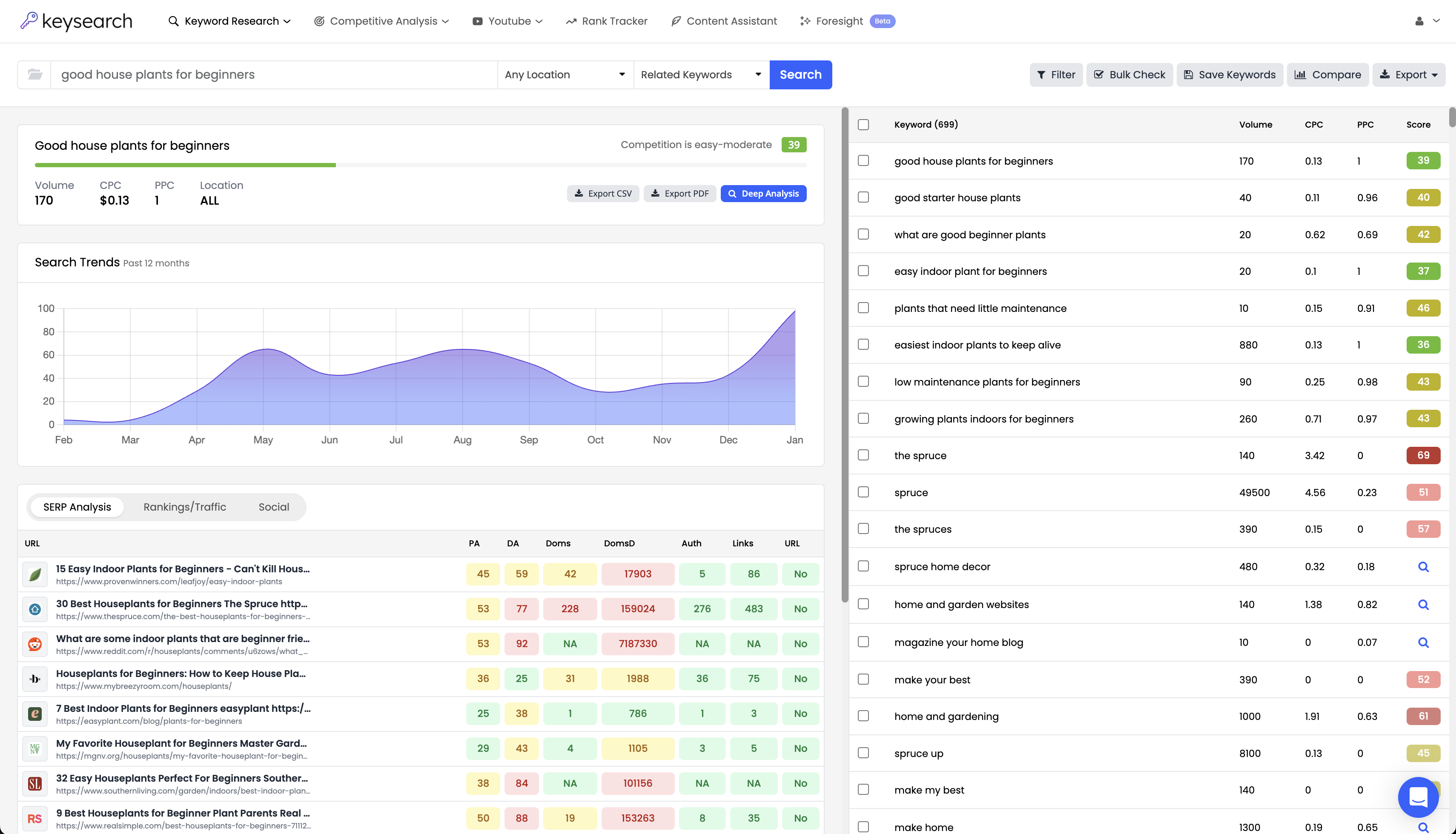Even if you sell a unique product, it can feel like your listing is getting lost amidst the countless other options on Etsy. You’re competing with tons of other sellers for the same customer pool.
This may leave you struggling to generate sales, finding yourself highly reliant on advertising which can eat into your profits. Or, maybe you’ve actually managed to start generating consistent sales – but you’re hungry for more.
Effective keyword research on Etsy can be the difference between sitting around waiting for orders to trickle in and watching your dashboard blow up with notifications from sale after sale.
We’ll walk you through how to do Etsy keyword research here in this guide so you can build an optimized listing that brings in customers on autopilot without having to spend on advertising.
With our powerful Etsy keyword tool you’ll know exactly which phrases you need to include in your product title, description, and tags to start generating organic traffic, and thus, sales.
It’s trusted by more than 10,000 active monthly users and includes everything you need for Etsy SEO. Get started today for free and see what KeySearch can do for your online storefront!
Overview of Etsy Keyword Research
Let’s start with the basics – what is Etsy keyword research and why is it so important? This process helps you create a well-optimized listing so that the right people find your products. In this sense, it’s a key component of any successful Etsy storefront.
What is Etsy?
Etsy is a popular online marketplace for sellers of handmade, vintage, and unique goods. It provides a platform for you to reach a global audience, whether you sell crafts, jewelry, clothing, home decor, or anything in between.
Etsy’s user-friendly interface and community-driven approach make it an ideal place for small business owners and creatives to showcase their products. You don’t need to build your own website or find your own traffic source – just create an account, list your items, and watch the sales flow in!
So you’d hoped, at least – but maybe you’ve struggled to get any traction. With millions of listings, standing out on this platform requires a sound strategy involving SEO tactics, which is where keyword research comes in.
Why Your Store Won’t Succeed Without Keyword Research
As the name suggests, keyword research is simply the process of finding the words and phrases your ideal customers are searching for to find goods like yours.
For example, if you sell handmade candles, your customers likely use phrases such as “handmade candles” or “candles made by hand” when shopping. But they probably search more specific keywords, too – like “organic artisan-made candles for fall”.
There’s only one way to know for sure what your customers are looking for, though – and that’s an effective keyword research process. Otherwise, you’re playing a guessing game, which will most often leave you spinning your wheels failing to gain traction on Etsy.
It’s not just about knowing what your customers are searching for, though – it’s about assessing things like difficulty, relevance, and more to ensure your optimization efforts are well-rounded. Here’s why learning how to do Etsy keyword research is so important for any seller, big or small:
- Visibility: Without the right keywords, your listings may not be seen by potential buyers.
- Relevance: Using relevant keywords ensures that your products are found by the right audience, increasing the conversion rate for your store.
- Competitive Advantage: Proper keyword research gives you an edge over competitors who may not be optimizing their listings correctly. You’ll show up for the searches they aren’t even thinking about.
- SEO Optimization: Keywords are a fundamental component of SEO, not just on Etsy, but any search engine – including Google. By optimizing your listings, descriptions, and tags, you may start ranking on Google and tap into a whole new pool of potential buyers.
So, let’s walk you through how to find keywords for Etsy below with our simple guide.
How to Do Etsy Keyword Research: Step-by-Step Guide
As we said from the start, finding the best opportunities for your Etsy store is as simple as setting up a KeySearch account and letting our software do the heavy lifting for you.
This saves you time and boosts your odds of success as we pull the most comprehensive data directly from Etsy’s search engine, so you know exactly what your customers are searching.
That being said, there are other ways you can do keyword research on Etsy as well – some of these are entirely free and can deliver powerful insights. If you’ve been selling on the platform for some time already, your existing data is an excellent starting point.
Start By Looking at the Data You Already Have
Etsy provides detailed statistics on your shop’s performance that will show you which terms shoppers are using to find your products. These terms can be a goldmine for understanding what converts.
You can find this information in your Etsy Dashboard under Stats, then, Search Terms. You’ll be shown the search traffic for both Etsy and Google so you see not just what’s working, but where it’s working best.
Another option is to look at Search Analytics under the Marketing tab of your dashboard. This view will present you with keywords that you can sort by either impressions or visits. You may find opportunities that don’t exist in your listings yet.
You can also look at your sales data to determine which specific SKUs are selling well. Take note of the keywords being used throughout your listings on these best sellers, as you can likely replicate the success across other listings.
Running ads on Etsy won’t just bring in immediate sales, it helps you gather more of this type of data that you can use to your advantage.
This was a far more powerful tool in the past, as Etsy has unfortunately made changes to the data you have access to through your ads. Still, you may find this useful if you have a high enough ad spend.
Using Etsy’s Search Feature for Keyword Ideas
Have you ever tried typing something into a search bar and seen a bunch of suggestions pop-up? This is a key feature on Google, YouTube, and even Etsy – and you can use this to find great long-tail keyword opportunities for your storefront.
This autocomplete information is presented because the algorithm knows what other users before you have searched. So, start by typing a broad keyword related to your product into Etsy’s search bar. Etsy will automatically suggest popular search terms.
There’s another way you can find these types of suggestions. After entering a search, scroll to the bottom of the page and look for the section titled “Related to [your search term].”
Etsy sometimes highlights trending searches on the homepage as well. These can offer insights into seasonal trends or emerging popular terms that you might want to incorporate into your listings.
Identifying the Best Opportunities for Your Store Through KeySearch
You may find a few ideas just using the data you’ve already collected and Etsy’s native search feature. However, learning how to do keyword research for Etsy is as simple as getting set up with KeySearch. Our free SEO tools deliver the top keywords for your niche in just a few clicks. Here’s how it works:
- Enter Seed Keywords: These are the broad terms that describe your products. KeySearch will generate a list of related keywords along with important metrics like search volume, competition, and CPC (Cost Per Click).
- Analyze the Metrics: Higher search volumes mean more potential traffic – it’s tempting to just focus on this metric. However, you should also pay attention to the competition score. Keywords with high competition can be harder to rank for, so you’ll need to find a balance.
- Focus on Long-Tail Keywords: Long-tail keywords are longer, more specific phrases that often have lower competition but higher conversion rates. For example, instead of targeting “jewelry,” you might target “handmade silver jewelry for women.” These keywords attract buyers who are closer to making a purchase decision, and they tend to be easier to rank for as well.
- Filter and Prioritize: Use KeySearch’s filtering options to narrow down your list. Focus on keywords that have a good balance of search volume and competition. Prioritize those that are most relevant to your products and audience.
Our tool merges the data from Etsy’s own search engine with insights from Google Adwords. This way, you’re not only capturing more traffic from within Etsy but bringing in customers from Google as well. Here are some other tools you gain access to with a single KeySearch subscription:
- Keyword clustering tool
- Keyword density checker
- Keyword difficulty checker
- LSI keyword generator
- Duplicate content checker
It’s not just the best Etsy keyword tool, either. You can use KeySearch to optimize listings on other platforms as well – whether you need an Amazon keyword tool, eBay keyword tool, Pinterest keyword tool, or YouTube keyword tool.
So, try it out today and see for yourself how to do keyword research on Etsy in just a few clicks with KeySearch. We’ll offer more tips below, like using your competitor’s success to your advantage.
Leveraging Competitor Analysis Methods
There’s no need to reinvent the wheel – your competitors may have already done extensive keyword research and optimized their listings accordingly.
So, take the time to find out who your closest competitors are – ideally, those that are earning sales using SEO. See who constantly pops up around the top of the page for your target keywords.
It can be as simple as analyzing their listings and jotting down key details. This includes titles, descriptions, and tags used in their listings. Better yet, you can use KeySearch for this as well.
Take their URL and plug it into one of our competitive analysis tools. The organic keywords tool shows you all their keywords ranked by traffic, volume, or rank. You can look at just a single page or their entire domain.
For a more close comparison, use the competitor gap feature. This allows you to input their store alongside yours to see which keywords they’re ranking for that you are not. You can even include up to 3 different competitors for the most thorough analysis possible.
Balancing Search Volume With Difficulty and Relevancy
We briefly touched on this earlier, but it’s important that you balance search volume with difficulty and relevancy as you prioritize your next steps. It’s not just about targeting keywords with the highest traffic potential – they need to be attainable, and they need to be valuable for your specific business.
KeySearch’s difficulty score helps you understand how hard it will be to rank for a particular keyword. Focus on keywords with lower difficulty scores, especially if your store is new or doesn’t have a lot of authority yet.
Like we said, long-tail keywords often hit the sweet spot of being relevant, less competitive, and still having decent search volume. While it may not blow you away in terms of traffic potential, it’s the conversions that matter, after all.
You can still target difficult keywords as long as they’re ultra-relevant to what you’re selling on Etsy. You just need to set your expectations and understand that these types of keywords will take far longer to rank for, and there’s no guarantee you’ll ever land in the top spots.
All of this is to say that you should dedicate resources towards quick wins while still focusing on the long-term goals for your Etsy store. Hopefully, you feel confident in how to do Etsy keyword research at this point – but what do you do with all this information now?
Tips on Optimizing Your Etsy Store After Conducting Keyword Research
Actually uncovering the best Etsy keywords for your store is just the first step. Now it’s a matter of optimizing your listings accordingly. We’ll cover everything you need to know about where to put keywords throughout your Etsy store below, starting with the most important: the title.
Crafting Optimized Product Titles
Your product title is one of the first things potential buyers see and one of the dominant ranking factors in Etsy’s search engine.
Place your main keyword upfront with any descriptors at the end. For example, instead of “Beautiful Handmade Soap – Lavender Scented”, use “Lavender Scented Handmade Soap – Natural Skincare”, or something of that nature.
You only have so many characters you can use in your title – we recommend using all of them if possible. You’ll need to balance being concise with offering as much description as possible. You can try split-testing different titles and see what converts better.
Writing Detailed and Keyword-Rich Descriptions
Your product description provides an opportunity to go into more detail about your item and incorporate keywords naturally. There should be a balance here between incorporating keywords and writing in a manner that earns the readers’ trust and promotes your product.
Integrate primary and secondary keywords throughout your description without keyword stuffing. Aim for a natural flow that reads well – our keyword density checker can help you with this step. Generally, just 1-2 uses of the main keyword in your description is plenty. After that, you can start to incorporate long-tail variations.
The key to any product description is to answer all the questions or uncertainties the reader may have. What makes your product unique? Why should a customer buy it? Highlight the materials used, the process of making the product, and any other unique selling points.
Optimizing Tags and Categories
Tags and categories help Etsy understand and categorize your products. You’re given 13 tags to fill out – similar to the character count in your title, we encourage you to make the most of them.
Mix broad keywords with specific, long-tail keywords to reach different segments of your target audience. For example, if you sell handmade jewelry, include tags like “artisan jewelry,” “boho jewelry,” and “custom jewelry.”
This should go without saying, but make sure you’re listing your product under the correct category as well. Otherwise, you’ll have a hard time getting discovered by potential customers.
Utilizing High-Quality Images
High-quality images not only attract customers but also help with SEO when optimized correctly. You can change your file name to match your keyword targeting – for example, instead of “IMG1234.jpg,” use “lavender-scented-handmade-soap.jpg.”
You should also add alt text to your images that include relevant keywords. This helps search engines understand what the image is about and can improve your SEO.
Best practices for images, in general, are to use the highest-resolution images, incorporate a balance of product images and lifestyle images, and use icons/text in some images to highlight key features/benefits.
Tracking Rankings Over Time
KeySearch allows you to monitor your progress through our rank-tracking feature. This helps you gauge the success of your efforts and look for room for improvement.
For instance, if you find that a certain listing is stuck in position 5, see what you can do to push it above the fold by revamping your title or description. Or, if you decide to make a change to your product title to try and improve click-through rate, watch to see if it negatively impacts your rankings.
Remember, SEO – whether on Google, Etsy, or any other platform – is an ongoing battle. But, now that you know how to find keywords for Etsy, it’s time to hit the ground running!
Parting Thoughts on How to Do Keyword Research for Etsy
That concludes our guide on how to do Etsy keyword research. This can be the difference between your store never seeing the light of day and organic sales pouring in as you dominate the SERPs.
Start by seeing what you can find from your own data and then supplement those findings with the unparalleled insights awaiting you in KeySearch – the most intuitive Etsy keyword research tool you have at your disposal.
If you’re currently using another tool and want to see how you can benefit from switching to KeySearch, or you’re simply curious about how we stack up to the competition, explore our comparisons below:
The best way to find out what makes KeySearch such a powerful tool in your Etsy keyword research efforts, though, is to see it in action firsthand. With a free trial just a few clicks away, what are you waiting for? See how simple learning how to do keyword research for Etsy can be with our solution today.
- How to Do Keyword Research for Free: Best Free Keyword Research Tools in 2024 - December 13, 2024
- Benefits of Keyword Clustering: Why is it Important to Group Relevant Keywords Together? - December 13, 2024
- What is Keyword Density in SEO and Its Importance - December 13, 2024







